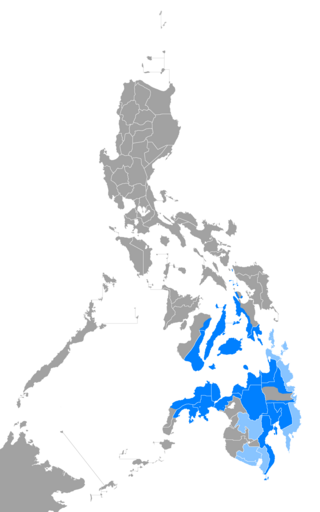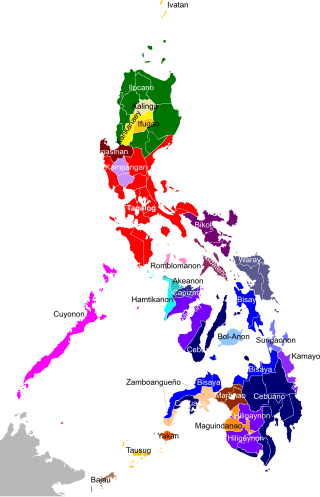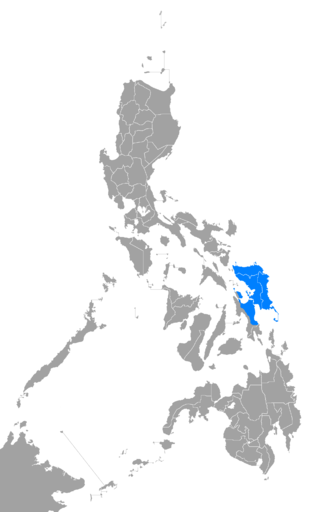
The Visayas, or the Visayan Islands, are one of the three principal geographical divisions of the Philippines, along with Luzon and Mindanao. Located in the central part of the archipelago, it consists of several islands, primarily surrounding the Visayan Sea, although the Visayas are also considered the northeast extremity of the entire Sulu Sea. Its inhabitants are predominantly the Visayan peoples.

Taglish or Englog is code-switching and/or code-mixing in the use of Tagalog and English, the most common languages of the Philippines. The words Taglish and Englog are portmanteaux of the words Tagalog and English. The earliest use of the word Taglish dates back to 1973, while the less common form Tanglish is recorded from 1999.

Cebuano is an Austronesian language spoken in the southern Philippines. It is natively, though informally, called by its generic term Bisayâ or Binisayâ and sometimes referred to in English sources as Cebuan. It is spoken by the Visayan ethnolinguistic groups native to the islands of Cebu, Bohol, Siquijor, the eastern half of Negros, the western half of Leyte, and the northern coastal areas of Northern Mindanao and the Zamboanga Peninsula. In modern times, it has also spread to the Davao Region, Cotabato, Camiguin, parts of the Dinagat Islands, and the lowland regions of Caraga, often displacing native languages in those areas.

Visayans or Visayan people are a Philippine ethnolinguistic family group or metaethnicity native to the Visayas, the southernmost islands of Luzon and a significant portion of Mindanao. They are composed of numerous distinct ethnic groups, many unrelated to each other. When taken as a single group, they number around 33.5 million. The Visayans, like the Luzon Lowlanders were originally predominantly animist-polytheists and broadly share a maritime culture until they were colonized in the 16th century and a Christian belief system was imposed on them under centuries of colonial rule by Western imperialists. In more inland or otherwise secluded areas, ancient animistic-polytheistic beliefs and traditions either were reinterpreted within a Roman Catholic framework or syncretized with the new religion. Visayans are generally speakers of one or more of the distinct Bisayan languages, the most widely spoken being Cebuano, followed by Hiligaynon (Ilonggo) and Waray-Waray.
Filipino English may refer to:

Chavacano or Chabacano is a group of Spanish-based creole language varieties spoken in the Philippines. The variety spoken in Zamboanga City, located in the southern Philippine island group of Mindanao, has the highest concentration of speakers. Other currently existing varieties are found in Cavite City and Ternate, located in the Cavite province on the island of Luzon. Chavacano is the only Spanish-based creole in Asia. The 2020 Census of Population and Housing counted 106,000 households generally speaking Chavacano.

The Bisayan languages or Visayan languages are a subgroup of the Austronesian languages spoken in the Philippines. They are most closely related to Tagalog and the Bikol languages, all of which are part of the Central Philippine languages. Most Bisayan languages are spoken in the whole Visayas section of the country, but they are also spoken in the southern part of the Bicol Region, islands south of Luzon, such as those that make up Romblon, most of the areas of Mindanao and the province of Sulu located southwest of Mindanao. Some residents of Metro Manila also speak one of the Bisayan languages.

The Philippines is inhabited by more than 182 ethnolinguistic groups, many of which are classified as "Indigenous Peoples" under the country's Indigenous Peoples' Rights Act of 1997. Traditionally-Muslim peoples from the southernmost island group of Mindanao are usually categorized together as Moro peoples, whether they are classified as Indigenous peoples or not. About 142 are classified as non-Muslim Indigenous people groups, and about 19 ethnolinguistic groups are classified as neither Indigenous nor Moro. Various migrant groups have also had a significant presence throughout the country's history.

Philippine Hokkien is a dialect of the Hokkien language of the Southern Min branch of the Sinitic family, primarily spoken vernacularly by Chinese Filipinos in the Philippines, where it serves as the local Chinese lingua franca, primarily spoken as an oral language, within the overseas Chinese community in the Philippines and acts as the heritage language of a majority of Chinese Filipinos. The use of Hokkien in the Philippines is influenced by Philippine Spanish, Filipino (Tagalog) and Philippine English. As a lingua franca of the overseas Chinese community in the Philippines, the minority of Cantonese-/Taishanese-descended Chinese Filipinos also uses Philippine Hokkien for business purposes due to its status as "the Chinoy business language" [sic].

The Waray people are a subgroup of the larger ethnolinguistic group Bisaya people, who constitute the 4th largest Filipino ethnolinguistic group in the Philippines. Their primary language is the Waray language, an Austronesian language native to the islands of Samar, Leyte and Biliran, which together comprise the Eastern Visayas Region of the Philippines. Waray people inhabit most of Samar where they are called Samareños/Samarnons, the northern part of the island of Leyte where they are called Leyteños, and the island of Biliran. In Leyte island, the Waray-speaking people are separated from the Cebuano-speaking Leyteños by the island's mountain range at the middle.
The Hiligaynon people, often referred to as Ilonggo people or Panayan people, are the second largest subgroup of the larger Visayan ethnic group, whose primary language is Hiligaynon, an Austronesian language of the Visayan branch native to Panay, Guimaras, and Negros. They originated in the province of Iloilo, on the island of Panay, in the region of Western Visayas. Over the years, inter-migrations and intra-migrations have contributed to the diaspora of the Hiligaynon to different parts of the Philippines. Today, the Hiligaynon, apart from the province of Iloilo, also form the majority in the provinces of Guimaras, Negros Occidental, Capiz, South Cotabato, Sultan Kudarat, and North Cotabato.
The Masbateño people refers to the people who lived in the Masbate province of the Philippines, which is part of the Bicol Region. They are part of the wider Visayan ethnolinguistic group, who constitute the largest Filipino ethnolinguistic group.
Bisaya Magasin is a weekly Cebuano magazine now published by the Manila Bulletin Publishing Corporation, Philippines. It has the record of being the oldest magazine in Cebuano which is still published, and "the most successful periodical in Cebuano".
The Aklanon people are the ethnolinguistic group who lived in the province of Aklan. They are part of the wider Bisaya ethnolinguistic group, who constitute the largest Filipino ethnolinguistic group.
Bisalog, also Tagbis, is a portmanteau of the words "Bisaya" and "Tagalog", referring to either a Visayan language or Tagalog being infused with words or expressions from the other. It can also be an informal term for Visayan languages spoken in Mimaropa, or Tagalog dialects infused with words from Visayan languages spoken there, such as in Marinduque.

Latík refers to two different coconut-based ingredients in Filipino cuisine. In the Visayan region it refers to a syrupy caramelized coconut cream used as a dessert sauce. In the northern Philippines, it refers to solid byproducts of coconut oil production, used as garnishing for a variety of desserts.

The Bible has been translated into multiple Philippine languages, including Filipino language, based on the Tagalog, the national language of the Philippines.

Hiligaynon, also often referred to as Ilonggo or Binisaya/Bisaya nga Hiniligaynon/Inilonggo, is an Austronesian regional language spoken in the Philippines by about 9.1 million people, predominantly in Western Visayas and Soccsksargen, most of whom belong to the Hiligaynon people. It is the second-most widely spoken language in the Visayas and belongs to the Bisayan languages, and it is more distantly related to other Philippine languages.

Waray is an Austronesian language and the fifth-most-spoken native regional language of the Philippines, native to Eastern Visayas. It is the native language of the Waray people and second language of the Abaknon people of Capul, Northern Samar, and some Cebuano-speaking peoples of western and southern parts of Leyte island. It is the third most spoken language among the Bisayan languages, only behind Cebuano and Hiligaynon.

Hokaglish, also known by locals as Sa-lam-tsam oe, is an oral contact language primarily resulting among three languages: (1) Philippine Hokkien Chinese, (2) Tagalog/Filipino and (3) Philippine English.














